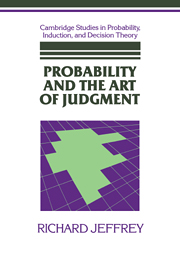Book contents
- Frontmatter
- Contents
- Preface
- 1 Introduction: Radical probabilism (1991)
- 2 Valuation and acceptance of scientific hypotheses (1956)
- 3 Probable knowledge (1968)
- 4 Probability and the art of judgment (1985)
- 5 Bayesianism with a human face (1983)
- 6 Alias Smith and Jones: The testimony of the senses (1987)
- 7 Conditioning, kinematics, and exchangeability (1988)
- 8 Preference among preferences (1974)
- 9 On interpersonal utility theory (1971)
- 10 Remarks on interpersonal utility theory (1974)
- 11 Mises redux (1977)
- 12 Statistical explanation vs. statistical inference (1969)
- 13 New foundations for Bayesian decision theory (1965)
- 14 Frameworks for preference (1974)
- 15 Axiomatizing the logic of decision (1978)
- 16 A note on the kinematics of preference (1977)
14 - Frameworks for preference (1974)
Published online by Cambridge University Press: 05 June 2012
- Frontmatter
- Contents
- Preface
- 1 Introduction: Radical probabilism (1991)
- 2 Valuation and acceptance of scientific hypotheses (1956)
- 3 Probable knowledge (1968)
- 4 Probability and the art of judgment (1985)
- 5 Bayesianism with a human face (1983)
- 6 Alias Smith and Jones: The testimony of the senses (1987)
- 7 Conditioning, kinematics, and exchangeability (1988)
- 8 Preference among preferences (1974)
- 9 On interpersonal utility theory (1971)
- 10 Remarks on interpersonal utility theory (1974)
- 11 Mises redux (1977)
- 12 Statistical explanation vs. statistical inference (1969)
- 13 New foundations for Bayesian decision theory (1965)
- 14 Frameworks for preference (1974)
- 15 Axiomatizing the logic of decision (1978)
- 16 A note on the kinematics of preference (1977)
Summary
If I now prefer p to q, what sorts of entities are the prospects p and q? In 1954, Savage [10] answered this question in what he took to be behavioristic terms: Prospects – the terms of the preference relation – are functions from a set S of states of nature to a set C of consequences. He called such functions “acts.” A decade or so later, Bolker and I answered it differently: Prospects are propositions, i.e., (nearly enough) sets of possible states of nature where the human agent is taken to be part of nature and his acts are thus ingredients in states of nature. Now, branching off from work of Luce and Krantz, Balch and Fishburn propose a hybrid answer: Prospects are act–event pairs and probability mixtures of such pairs. With Savage, they treat man and nature – acts and events – dualistically. Their treatment of acts is far more satisfactory than Savage's, and they are to be commended for the step toward holism which they take in dropping Savage's extraneous set C of consequences. But I will argue for the fully holistic or naturalistic position in which preference is a ranking of events (or propositions), some of which are acts.
With Balch and Fishburn, I find Savage's system unacceptable. Choice ought to reveal preference to at least this degree: The prospect which the agent chooses ought to be one of the highest in his preference ranking which he takes to be options for him.
- Type
- Chapter
- Information
- Probability and the Art of Judgment , pp. 226 - 231Publisher: Cambridge University PressPrint publication year: 1992



